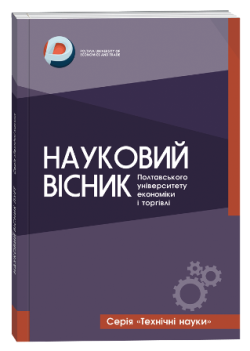FATTY ACID CONTENT AND BIOLOGICAL VALUE OF OIL OBTAINED FROM SPROUTED SOFT WHEAT GRAIN
Abstract
A number of scientific works have been devoted to the study of methods of obtaining oil from wheat germ. However, the research concerns the methods of obtaining such oil. Research results of the production and quality of oil from sprouted soft wheat grain have not been sufficiently covered. The purpose of the article is to study the content of fatty acids and the biological value of oil obtained from sprouted soft wheat grain. The results of research indicate that the main fatty acid and the main PUFA component of oil from sprouted soft wheat grain is linoleic acid – 55.1%. In addition, the PUFA content in this oil was at the level of 61.9%. The content of EFA and MUFA was 17.6 and 15.3%, respectively, that is, it was almost the same. The content of palmitic fatty acid was the highest in EFA– 16.8%. The content of myristic and stearic fatty acids was in the range of 0.2–0.6%. The content of oleic fatty acid was the highest in MUFA – 14.7%. The content of palmitoleic fatty acid was at the level of 0.6%. It should be noted that oil from sprouted soft wheat grain can be a source of PUFA, as it exceeds the daily requirement of the human body by 6 times. While the integral score was 619.0%. Consumption of 100 g of such oil provides the human body with 58.7% of EFA and 25.5% of MUFA. The oil from sprouted soft wheat grain also contains some other biologically active substances. Thus, 100 g of oil contained the most vitamin E – 151.2 mg. In case of consumption of 100 g of this oil, it is 10 times higher than the human body's daily need for vitamin E. In addition, vitamin K content was 0.026 mg/100 g, the integral score of which was 35.0%. Vitamin B4 content was the lowest – 20.5 mg/100 g. 100 g of oil met its daily need by only 4.1%. It should be noted that the oil from sprouted soft wheat grain contained phytosterols – 558 mg/100 g. Therefore, the oil from sprouted soft wheat grain can be a source of high content of PUFA ω-6 and vitamin E. This creates prerequisites for the expediency of using oil or processed products of sprouted soft wheat grain in the production technology of increased biological value products.
References
2. Любич В. В. Продуктивність сортів і ліній пшениць залежно від абіотичних і біотичних чинників. Вісник аграрної науки Причорномор’я. 2017. Вип. 95. С. 146–161.
3. Любич В. В. Біологічна цінність білка пшениці спельти залежно від походження сорту та лінії. Зб. наук. пр. Уманського НУС. 2016. Вип. 89. С. 199–206.
4. Rico D., Peñas E., Garcia M. C., Martinez-Villaluenga C., Rai D. K., Birsan R. I. Sprouted barley flour as a nutritious and functional ingredient. Foods. 2020. Vol. 9. Article number 296.
5. Hernandez-Espinosa N., Laddomada B., Payne T., Huerta-Espino J., Govindan V., Ammar K., Ibba M. I., Pasqualone A., Guzman C. Nutritional quality characterization of a set of durum wheat landraces from Iran and Mexico. LWT Food Sci. Technol. 2020. Vol. 124. Article number 109198.
6. Ikram A., Saeed F., Afzaal M., Imran A., Niaz B., Tufail T., Hussain M., Anjum F.M. Nutritional and end-use perspectives of sprouted grains: A comprehensive review. Food Sci. Nutr. 2021. Vol. 9. Р. 4617–4628.
7. Laddomada B., Durante M., Mangini G., D’Amico L., Lenucci M. S., Simeone R., Piarulli L., Mita G., Blanco A. Genetic variation for phenolic acids concentration and composition in a tetraploid wheat (Triticum turgidum L.) collection. Genet. Resour. Crop Evol. 2017. Vol. 64. Р. 587–597.
8. Любич В. В. Значення виду жирозамінника в технології кексів. Вісник Уманського НУС. 2022. № 1. С. 88–94.
9. Liao M., Damayanti W., Zhao Y., Xu X., Zheng Y., Wu J., Jiao S. Hot air-assisted radio frequency stabilizing treatment effects on physicochemical properties, enzyme activities and nutritional quality of wheat germ. Food Bioprocess Technol. 2020. Vol. 13. Р. 901–910.
10. Srivastava A. K., Sudha M. L., Baskaran V., Leelavathi K. Studies on heat stabilized wheat germ and its influence on rheological charactaeristics of dough. Eur. Food Res. Technol. 2006. Vol. 224. Р. 365–372.
11. Li B., Zhao L., Chen H., Sun D., Deng B., Li J., Liu Y., Wang F. Inactivation of lipase and lipoxygenase of wheat germ with temperature-controlled short wave infrared radiation and its effect on storage stability and quality of wheat germ oil. PLoS ONE. 2016. Vol. 11. Article number e0167330.
12. Miyahara R. F., Lopes J. O., Antunes A. E. C. The use of sprouts to improve the nutritional value of food products: A brief review. Plant Foods Hum. Nutr. 2021. Vol. 76. Р. 143–152.
13. Marzocchi S, Caboni MF, Greco Miani M, Pasini F. Wheat Germ and Lipid Oxidation: An Open Issue. Foods. 2022. Vol. 11(7). Article number 1032.
14. Márton M., Mándoki Z. S., Csapo J. Evaluation of biological value of sprouts. I. Fat content, fatty acid composition. Acta Univ. Sapientiae Aliment. 2010. Vol. 3. Р. 53–65.
15. Narducci V., Finotti E., Galli V., Carcea M. Lipids and fatty acids in Italian durum wheat (Triticum durum Desf.) cultivars. Foods. 2019. Vol. 8. Article number 223.
16. Dhillon B., Choudhary G., Sodhi N.S. A study on physiochemical, antioxidant and microbial properties of germinated wheat flour and its utilization in breads. J. Food Sci. Technol. 2020. Vol. 57. Р. 2800–2808.


